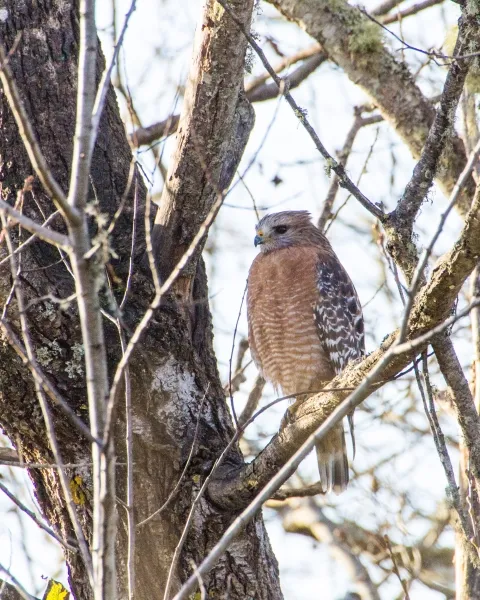Birds of prey, known as raptors, command respect worldwide for their impressive size, speed, and hunting prowess. From sports team names like the Falcons and Seahawks to cultural symbols, these magnificent creatures inspire awe. However, during nesting season, raptors and other birds can display aggressive behavior that catches people off guard. If you’re a bird enthusiast or simply live near wooded areas, understanding raptor aggression is crucial for safe interactions.
Most birds turn aggressive only when they feel threatened, especially while guarding nests. Common encounters happen with species like Northern mockingbirds or raptors nesting in human-populated zones. From January to August, birds such as red-tailed hawks, red-shouldered hawks, Cooper’s hawks, Swainson’s hawks, Northern goshawks, broad-winged hawks, and peregrine falcons may swoop at intruders. Goshawks are notorious for aerial dives, while aggression levels vary by species.
This defensive instinct protects eggs and fledglings, mirroring behaviors seen in other birds like geese nesting behavior. Recognizing these patterns helps prevent conflicts and ensures respect for wildlife.
Defensive Behavior
Birds employ a range of tactics to ward off threats. Upon sensing danger, many emit loud calls or hisses—high-pitched, sharp, and repetitive until the intruder retreats. Distressed birds often puff up their feathers to appear larger, weaving anxiously side to side. If these displays fail, they escalate to lunges or dive-bombing attacks using wings, talons, and beaks.
This posturing is a universal warning among birds, similar to displays in heron behavior or even pet species like those exhibiting parrot aggression. Raptors, with their powerful builds, make these defenses particularly intimidating. Experts from the U.S. Fish and Wildlife Service (USFWS) note that such behaviors peak during breeding, emphasizing the bird’s commitment to its young.
 Red-tailed hawk in flight
Red-tailed hawk in flight
Red-tailed hawk soaring aggressively. Credit: Tim Ludwick/USFWS
What to Do If You Encounter an Aggressive Bird
Patience is key when facing a distressed raptor. Acknowledge the behavior as protective parenting, not malice. Avoid the nest area until fledglings leave, reducing perceived threats. Never approach or handle wild birds—their strength can cause serious injury via scratches or pecks.
Practical deterrents include erecting flagged poles along paths near nests, carrying an open umbrella or flagged stick overhead (raptors target the highest silhouette), and posting warning signs. Portable canopies shield walkways effectively. If attacked and skin breaks, clean the wound thoroughly with antiseptic—birds don’t transmit rabies this way.
These strategies draw from real-world experiences shared by wildlife professionals, ensuring safety without harm. For context on similar protective instincts, see bald eagle nesting behavior.
 Red shouldered hawk perched
Red shouldered hawk perched
Red-shouldered hawk on perch, ready to defend. Credit: Tim Ludwick/USFWS
Recommendations to Prevent Future Attacks
Post-fledging, remove empty nests to discourage reuse. During the next breeding season, dismantle new nests early—but watch for heightened aggression. Pre-season tree trimming by certified arborists removes ideal nesting spots.
These proactive steps minimize risks while respecting natural cycles. Combining them with education fosters coexistence, much like managing behaviors in captive birds such as male lovebird mating behavior.
Legal Status
Raptors and listed species are protected under the Migratory Bird Treaty Act of 1918, prohibiting taking, possessing, selling, or disturbing without permits. “Take” includes pursuing, harming, or collecting nests/eggs.
Active nests (with eggs/chicks) require U.S. Fish and Wildlife Service permits for removal, justified by health/safety hazards. Observe from afar with binoculars: a bird settling after 15-20 minutes signals activity. Empty nests can be cleared permit-free. Always consult state agencies—nuisance permits aren’t issued.
Conclusion
Raptor aggression stems from fierce parental instincts, peaking in nesting season. By understanding signals, using deterrents, and following legal guidelines, you can safely navigate encounters. Prioritize observation over interference, and consult local wildlife experts for persistent issues.
Stay informed on bird behaviors through trusted resources—your awareness protects both wildlife and people. Explore more on our site for tips on various species!
References
- U.S. Fish and Wildlife Service (USFWS): Guidelines on migratory birds and nest defense.
- Migratory Bird Treaty Act of 1918 (50 CFR 10.12).
